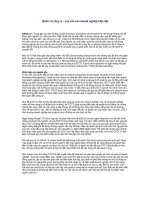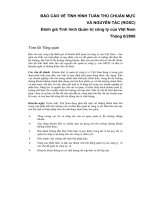Thẻ điểm quản trị công ty tiếng anh
Bạn đang xem bản rút gọn của tài liệu. Xem và tải ngay bản đầy đủ của tài liệu tại đây (86.86 KB, 4 trang )
Thẻ điểm quản trị công ty
• Thẻ điểm công ty- Corporate Governance Scorecard (CGS)
• The Corporate Governance Scorecard: A Tool for the Implementation of
Corporate Governance (Christian Strenger)
Recent empirical research confirms that companies with demanding
governance standards achieve higher market valuations. Due to the
complexity of specific corporate governance matters, there is a rising need
for a systematic and quantitative evaluation approach for corporate
governance. In Germany, a Corporate Governance Scorecard has been
developed that fulfils the key goals defined by analysts and investors. It has
a standardised format, can be applied efficiently, is available at no cost and
enables self-assessments by companies as well as sector-specific
comparisons. The German Scorecard has not only found good reception at
the national financial community, but has also been adapted around the
world, especially in emerging countries.
Sources: />• Như vậy CGS có một số đặc điểm tóm tắt được như sau:
- Thẻ điểm quản trị công ty xuất phát từ nước Đức.
- Sử dụng để khẳng định các công ty lớn có đạt tiêu chuẩn quản trị cao.
- Thẻ điểm có những tiêu chuẩn đã được định dạng sẵn, các công ty tự
đánh giá và so sánh trên các lĩnh vực cụ thể.
• Main goals of the Scorecard approach
The Scorecard should:
- Facilitate the work of analysts and investors through a systematic and
easy
overview of all relevant issues of good governance.
- Enable companies to easily assess the ‘reach’ and the quality of their
own
governance situation.
- Allow to set minimum scores by investors for governance as part of
general investment politics.
- Enable comparisons across industries and countries.
- Be readily available to all interested parties via the internet.
- Ensure high degrees of usage: the completion of the Scorecard via
programmed tools (MS Excel) should therefore be possible.
Sources: (The Corporate Governance Scorecard – a Tool for the
Implementation of Corporate Governance by Christian Strenger
Member,
German
Government
Commission
on
Corporate
Governance Director, DWS Investment GmbH, Frankfurt)
• Scorecard Methodology:
- The approach:
The Scorecard should enable the user to evaluate corporate governance principles
and practices in a quick but systematic fashion with a concise structure of the
major criteria with relevant individual points. In the case of the German Scorecard,
the user assesses the degree of fulfillment of each point by marking the
corresponding field in the column ‘Fulfillment’. Three choices (yes, partially, no)
exist for every point giving full, half or zero marks for each point. Especially for
debatable items, the source of information for the particular point is to be given in
the column ‘Information Source’. If a specific point cannot be dealt with due to
binding company specifics, the point can be marked with ‘yes’, but this evidently
does not apply if it conflicts with principles of good governance.
• Calculation and weighting of the Scorecard:
The calculation and weighting of the Scorecard should follow an easy path that
gives standard weightings but also allows the reflection of individual weighting
differences. The calculation should be menu-driven and follow proven methods
like MS Excel standard software. In the German example, each point is weighted
by a suggested 'standard weighting' following its deemed importance. The
percentages appear in the second column of the Scorecard. In order to allow an
individual approach, an individual weighting can be assigned to every point (third
column). This allows the Scorecard to reflect individual experiences and
preferences avoiding the usual 'box-ticking' problem of a too schematic approach.
The Scorecard then calculates the ‘Partial Scores’ in the fourth and fifth columns
by weighting the achieved points of each item. The last step, also automatically
achieved by the Scorecard, is the calculation of the ‘Total Score’. All partial scores
assigned to each of the seven criteria are weighted by the set percentage numbers
and then added up for the ‘Total Score’ in the overview page ‘Summary of
Results’.
• Governance evaluation criteria for the Scorecard:
The conceptual approach to the evaluation question should reward the
fulfillment of a good standard of governance and an active commitment with a
possible score of 65% - 75%. The remaining percentage should be achievable if
additional important governance items are fulfilled. Taking the German Scorecard
as the example: A company displaying an active ‘Corporate Governance
Commitment’ (first criterion) and fulfilling all ‘Recommendations’3 of the
‘German Corporate Governance Code’, reaches a score of 75%. If the additional
‘Suggestions’ of the Code4 and additional ‘best practice standards’ are fulfilled,
the maximum ‘Total Score’ of 100% can be achieved. This 25% gap over the
fulfillment of the ‘Recommendations’ is clearly meant to incentivise companies to
pursue more than the ‘Recommendations’. German companies with demanding
governance standards reach scores between 80% and 95%.
Tài liệu tham khảo
1. The Corporate Governance Scorecard – a Tool for the Implementation of
Corporate Governance, Christian Strenger Member, German Government
Commission on Corporate Governance Director, DWS Investment GmbH,
Frankfurt









